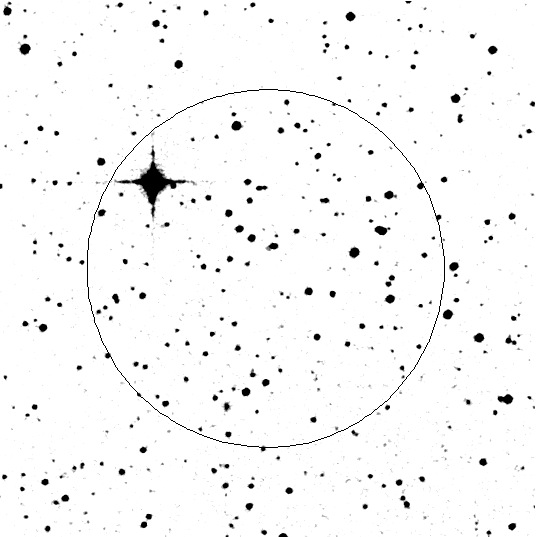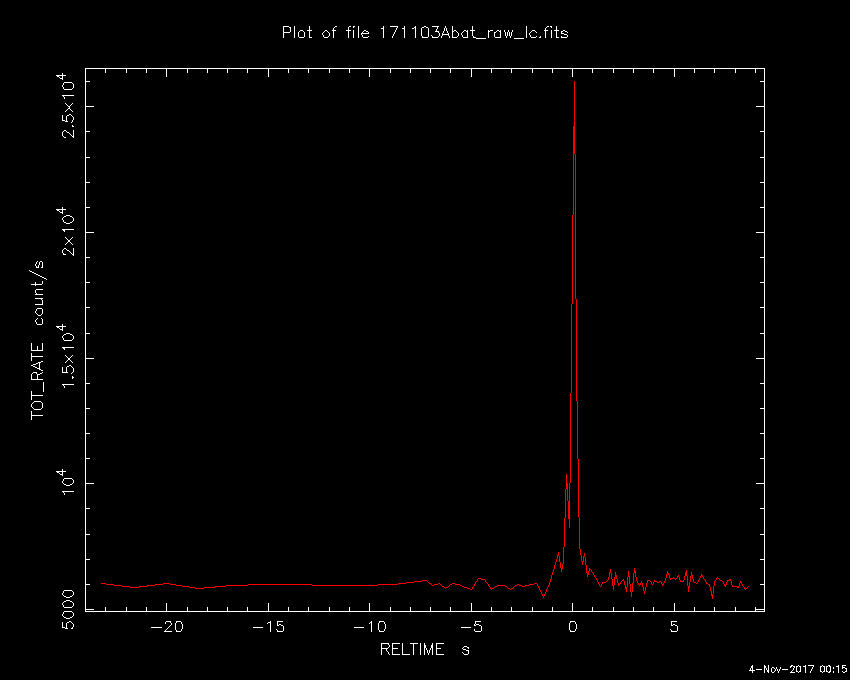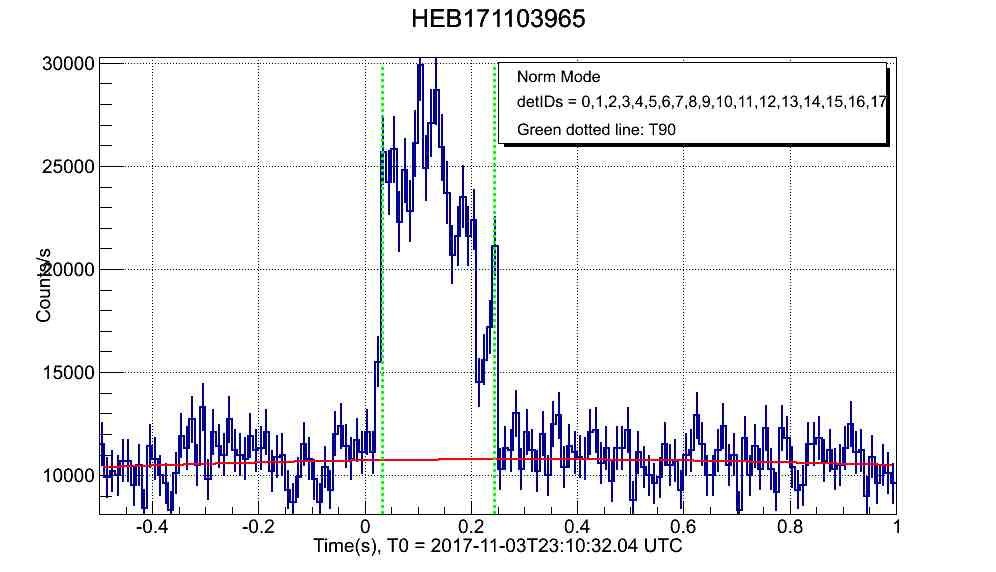- GCN/BACODINE POSITION NOTICE
TITLE: GCN/SWIFT NOTICE
NOTICE_DATE: Fri 03 Nov 17 23:10:44 UT
NOTICE_TYPE: Swift-BAT GRB Position
TRIGGER_NUM: 785850, Seg_Num: 0
GRB_RA: 249.536d {+16h 38m 09s} (J2000),
249.781d {+16h 39m 07s} (current),
248.848d {+16h 35m 24s} (1950)
GRB_DEC: -10.215d {-10d 12' 53"} (J2000),
-10.250d {-10d 14' 58"} (current),
-10.116d {-10d 06' 57"} (1950)
GRB_ERROR: 3.00 [arcmin radius, statistical only]
GRB_INTEN: 1181 [cnts] Image_Peak=121 [image_cnts]
TRIGGER_DUR: 0.064 [sec]
TRIGGER_INDEX: 10427 E_range: 50-350 keV
BKG_INTEN: 20040 [cnts]
BKG_TIME: 83420.05 SOD {23:10:20.05} UT
BKG_DUR: 8 [sec]
GRB_DATE: 18060 TJD; 307 DOY; 17/11/03
GRB_TIME: 83431.89 SOD {23:10:31.89} UT
GRB_PHI: -96.45 [deg]
GRB_THETA: 21.49 [deg]
SOLN_STATUS: 0x3
RATE_SIGNIF: 77.26 [sigma]
IMAGE_SIGNIF: 9.35 [sigma]
MERIT_PARAMS: +1 +0 +0 -4 +3 +0 -100 +0 -86 +0
SUN_POSTN: 219.29d {+14h 37m 09s} -15.35d {-15d 20' 58"}
SUN_DIST: 30.14 [deg] Sun_angle= -2.0 [hr] (East of Sun)
MOON_POSTN: 37.22d {+02h 28m 53s} +9.58d {+09d 34' 47"}
MOON_DIST: 147.93 [deg]
MOON_ILLUM: 100 [%]
GAL_COORDS: 6.75, 23.60 [deg] galactic lon,lat of the burst (or transient)
ECL_COORDS: 249.42, 11.77 [deg] ecliptic lon,lat of the burst (or transient)
COMMENTS: SWIFT-BAT GRB Coordinates.
COMMENTS: This is a rate trigger.
COMMENTS: A point_source was found.
COMMENTS: This does not match any source in the on-board catalog.
COMMENTS: This does not match any source in the ground catalog.
COMMENTS: This is a GRB.
COMMENTS: This trigger occurred at longitude,latitude = 258.98,16.56 [deg].
- red DSS finding chart
ps-file

- GCN NOTICE
TITLE: GCN/INTEGRAL NOTICE
NOTICE_DATE: Fri 03 Nov 17 23:11:18 UT
NOTICE_TYPE: INTEGRAL SPI ACS Trigger
TRIGGER_NUM: 7956, Sub_Num: 0
GRB_INTEN: 16.04 [sigma]
GRB_TIME: 83430.04 SOD {23:10:30.04} UT
GRB_DATE: 18060 TJD; 307 DOY; 17/11/03
COMMENTS: INTEGRAL SPI_ACS GRB Trigger.
COMMENTS: Time_Scale=2.0000 and Time_Error=1.0000.
COMMENTS:
COMMENTS: NOTE: This SPIACS event is temporally(1.0<100sec) coincident with the SWIFT_BAT event (trignum=785850).
COMMENTS:
COMMENTS: The SPIACS lightcurve can be found at:
COMMENTS: ftp://isdcarc.unige.ch/arc/FTP/ibas/spiacs/2017-11/2017-11-03T23-10-29.9126-03733-11152-0.lc
- GCN NOTICE
TITLE: GCN/SWIFT NOTICE
NOTICE_DATE: Fri 03 Nov 17 23:15:38 UT
NOTICE_TYPE: Swift-BAT GRB Lightcurve
TRIGGER_NUM: 785850, Seg_Num: 0
GRB_RA: 249.536d {+16h 38m 09s} (J2000),
249.781d {+16h 39m 07s} (current),
248.848d {+16h 35m 24s} (1950)
GRB_DEC: -10.215d {-10d 12' 53"} (J2000),
-10.250d {-10d 14' 58"} (current),
-10.116d {-10d 06' 57"} (1950)
GRB_DATE: 18060 TJD; 307 DOY; 17/11/03
GRB_TIME: 83432.06 SOD {23:10:32.06} UT
TRIGGER_INDEX: 10427
GRB_PHI: -96.45 [deg]
GRB_THETA: 21.49 [deg]
DELTA_TIME: 320.00 [sec]
TRIGGER_DUR: 0.064 [sec]
SOLN_STATUS: 0x3
RATE_SIGNIF: 77.26 [sigma]
IMAGE_SIGNIF: 9.35 [sigma]
LC_URL: sw00785850000msb.lc
SUN_POSTN: 219.29d {+14h 37m 10s} -15.35d {-15d 21' 02"}
SUN_DIST: 30.14 [deg] Sun_angle= -2.0 [hr] (East of Sun)
MOON_POSTN: 37.27d {+02h 29m 04s} +9.59d {+09d 35' 40"}
MOON_DIST: 147.98 [deg]
MOON_ILLUM: 100 [%]
GAL_COORDS: 6.75, 23.60 [deg] galactic lon,lat of the burst (or transient)
ECL_COORDS: 249.42, 11.77 [deg] ecliptic lon,lat of the burst (or transient)
COMMENTS: SWIFT-BAT GRB Lightcurve.
COMMENTS:
COMMENTS: The next comments were copied from the BAT_POS Notice:
COMMENTS: This is a rate trigger.
COMMENTS: A point_source was found.
COMMENTS: This does not match any source in the on-board catalog.
COMMENTS: This does not match any source in the ground catalog.
COMMENTS: This is a GRB.
COMMENTS: This trigger occurred at longitude,latitude = 258.98,16.56 [deg].
COMMENTS: The 3rd packet (of 3) was missing in the lightcurve data stream.

- GCN Circular #22095
T. N. Ukwatta (LANL), A. D'Ai (INAF-IASFPA), V. D'Elia (ASDC),
Alex Deich (PSU), H. A. Krimm (NSF/USRA), N. P. M. Kuin (UCL-MSSL),
D. M. Palmer (LANL), M. H. Siegel (PSU) and A. Tohuvavohu (PSU) report
on behalf of the Swift Team:
At 23:10:32 UT, the Swift Burst Alert Telescope (BAT) triggered and
located GRB 171103A (trigger=785850). Swift did not slew due to an
observing constraint.
The BAT on-board calculated location is
RA, Dec 249.536, -10.215 which is
RA(J2000) = 16h 38m 09s
Dec(J2000) = -10d 12' 53"
with an uncertainty of 3 arcmin (radius, 90% containment, including
systematic uncertainty). The BAT light curve showed a single-peaked
structure with a duration of less than 1 sec. The peak count rate
was ~20000 counts/sec (15-350 keV), at ~0 sec after the trigger.
Due to a Sun observing constraint, Swift cannot slew to the BAT
position until 11:32 UT on 2018 January 15. There will thus be no XRT
or UVOT data for this trigger before this time.
Burst Advocate for this burst is T. N. Ukwatta (tilan.ukwatta AT gmail.com).
Please contact the BA by email if you require additional information
regarding Swift followup of this burst. In extremely urgent cases, after
trying the Burst Advocate, you can contact the Swift PI by phone (see
Swift TOO web site for information: http://www.swift.psu.edu/too.html.)
- GCN Circular #22099
D. M. Palmer (LANL), S. D. Barthelmy (GSFC), J. R. Cummings (CPI),
H. A. Krimm (NSF/USRA), A. Y. Lien (GSFC/UMBC), C. B. Markwardt (GSFC),
J. P. Norris (BSU), T. Sakamoto (AGU), M. Stamatikos (OSU),
T. N. Ukwatta (LANL) (i.e. the Swift-BAT team):
Using the data set from T-239 to T+963 sec from the recent telemetry downlink,
we report further analysis of BAT GRB 171103A (trigger #785850)
(Ukwatta et al., GCN Circ. 22095). The BAT ground-calculated position is
RA, Dec = 249.510, -10.206 deg which is
RA(J2000) = 16h 38m 02.4s
Dec(J2000) = -10d 12' 22.9"
with an uncertainty of 1.5 arcmin, (radius, sys+stat, 90% containment).
The partial coding was 65%.
The mask-weighted light curve shows a complex multi-peak structure. It begins
with three peaks from -0.8 sec to +0.3 sec. This is followed by low-level, slowly
decaying emission out to ~T+20 sec and then a weaker peak at ~T+60 sec. The
spacecraft slewed away from the burst location at ~T+600 sec due to a
pre-planned slew. T90 (15-350 keV) is 3.90 +- 1.11 sec (estimated error
including systematics).
The time-averaged spectrum from T-0.37 to T+4.67 sec is best fit by a simple
power-law model. The power law index of the time-averaged spectrum is
1.31 +- 0.18. The fluence in the 15-150 keV band is 3.8 +- 0.4 x 10^-7 erg/cm2.
The 1-sec peak photon flux measured from T-0.37 sec in the 15-150 keV band
is 3.6 +- 0.3 ph/cm2/sec. All the quoted errors are at the 90% confidence
level.
The duration and hardness of this burst show it to be intermediate between the
short and long burst populations. Using a 8-ms binned light curve, the lag analysis
finds a lag of -0.5 +/- 4 ms for the 100-350 keV to 25-50 keV band, and -0.7 +/- 5 ms
for the 50-100 keV to 15-25 keV band. These values are consistent with those of
a short GRB.
The results of the batgrbproduct analysis are available at
http://gcn.gsfc.nasa.gov/notices_s/785850/BA/
- GCN Circular #22100
P Veres (UAH) reports on behalf of the Fermi GBM Team:
GRB 171103A, detected by Swift (Ukwatta et al, GCN #22095) is clearly
visible in the GBM data. It was not possible for GBM to trigger at
this time because GBM was still in trigger mode for a transient that
occurred 190 s earlier (171103963 / 531443246).
The angle from the Fermi LAT boresight at the Swift trigger time is
102 degrees.
The GBM light curve shows a single pulse with a duration (T90) of
about 1.1 s (50-300 keV). The time-averaged spectrum for a 0.4 s
interval starting from 23:10:31.951 UT is best fit by a power law
function with an exponential high-energy cutoff. The power law index
is -0.74 +/- 0.05 and the cutoff energy, parameterized as Epeak, is
2.1 +/- 0.2 MeV.
The event fluence (10-1000 keV) in this time interval is
(2.7 +/- 0.1)E-6 erg/cm^2. The 64-ms peak photon flux measured
starting from 23:10:32.082 in the 10-1000 keV band is
30.3 +/- 2.0 ph/s/cm^2.
- GCN Circular #22101
A. Tsvetkova, S. Golenetskii, R.Aptekar, D. Frederiks, P. Oleynik,
M. Ulanov, D. Svinkin, A. Lysenko, A. Kozlova and T. Cline
on behalf of the Konus-Wind team, report:
The short-duration, hard-spectrum, intense GRB 171103A
(Swift detection of a short hard burst: Ukwatta et al., GCN 22095;
Palmer et al., GCN 22099;
Fermi GBM observation: Veres, GCN 22100)
triggered Konus-Wind at T0=3D83429.176 s UT (23:10:29.176).
The burst light curve shows a single pulse with a total duration of ~0.3 s.
The emission is seen up to ~15 MeV.
As observed by Konus-Wind, the burst
had a fluence of 8.50(-1.47,+1.57)x10^-6 erg/cm2,
and a 16-ms peak energy flux, measured from T0-0.030 s,
of 7.12(-2.18,+2.26)x10^-5 erg/cm2/s
(both in the 20 keV - 10 MeV energy range).
The time-integrated spectrum of the burst
(measured from T0 to T0+0.256 s)
is best fit in the 20 keV - 15 MeV range
by a power law with exponential cutoff model:
dN/dE ~ (E^alpha)*exp(-E*(2+alpha)/Ep)
with=A0 alpha =3D -0.76(-0.17,+0.20),
and Ep =3D 2463(-690,+1054) keV (chi2 =3D 31/28 dof).
Fitting by the GRB (Band) model yields the same alpha and Ep,
and an upper limit on the high energy photon index:
beta < -1.98 (chi2 =3D 31/27 dof).
The Konus-Wind light curve of this GRB is available at
http://www.ioffe.ru/LEA/GRBs/GRB171103_T83429/
All the quoted errors are at the 90% confidence level.
All the quoted values are preliminary.
- GCN Circular #22103
V. Sharma and D. Bhattacharya (IUCAA), V. Bhalerao (IIT-B), A. R. Rao (TIFR) and S. Vadawale (PRL) report on behalf of the Astrosat CZTI collaboration:
Analysis of Astrosat CZTI data showed the detection of a short bright GRB 171103A, which was also detected by Swift-BAT (Ukwatta T. N. et al, GCN # 22095), Fermi-GBM (Veres P., GCN # 22100) and Konus-Wind (Tsvetkova A. et al, GCN # 22101).
The source was clearly detected in the 40-200 keV energy range. The light curve shows single peak of emission with peak at 23:10:32.100 UT. The measured peak count rate is 1420.9 cts/s above the background in combined data of four quadrants, with a total of 2964 cts. The local mean background count rate was 349.1 cts/s. Using cumulative rates, we measure a T90 of 0.46 s.
It was also clearly detected in the CsI anticoincidence (Veto) detector in the 100-500 keV energy range.
CZTI GRB detections are reported regularly on the payload site at http://astrosat.iucaa.in/czti/?q=grb. CZTI is built by a TIFR-led consortium of institutes across India, including VSSC, ISAC, IUCAA, SAC and PRL. The Indian Space Research Organisation funded, managed and facilitated the project.
- GCN Circular #22116
G. Li, J. Y. Liao, S. L. Xiong, C. K. Li, X. B. Li, C. Z. Liu,
X. F. Li, Z. W. Li, X. F. Lu, Z. Chang, J. L. Zhao, A. M. Zhang,
C. L. Zou (IHEP), Y. J. Jin, Z. Zhang (THU), T. P. Li (IHEP/THU),
F. J. Lu, L. M. Song, H. Y. Wang, M. Wu, Y. P. Xu, S. N. Zhang (IHEP),
report on behalf of the Insight-HXMT team:
During the commissioning phase, at 2017-11-03T23:10:32.04 (T0),
Insight-HXMT/HE detected GRB 171103A (trigger ID: HEB171103965)
in a routine search of the data,which is also detected by
Swift/BAT (Ukwatta et al.,GCN 22095), Fermi/GBM (Veres et al., GCN 22100)=
,
Konus-Wind (Tsvetkova et al.,GCN 22101) and AstroSat/CZTI
(Sharma et al., GCN 22103).
The Insight-HXMT light curve mainly consists of multi-pulses
with a duration (T90) of 0.21 s measured from T0+0.033 s.
The 10-ms peak rate, measured from T0+0.096 s, is 19946.0 cnts/sec.
The total counts from this burst is 2915.7 counts.
URL_LC: http://www.hxmt.org/images/GRB/HEB171103965_lc.jpg
All measurements above are made with the CsI detectors operating in the
regular mode with the energy range of about 80-800 keV (record energy).
Only gamma-rays with energy greater than about 200 keV can penetrate
the spacecraft and leave signals in the CsI detectors installed inside
of the telescope.
The time-averaged spectrum from T0+0.05 s to T0+0.30 s is
adequately fit by a Power Law model with spectral index =3D -0.97 =B1 0.0=
7.
The energy fluence is (4.1 =B1 0.3)e-6 erg/cm^2 in 200 - 5000 keV
in this time interval.
The analysis results presented above are preliminary;
final results will be published elsewhere.
Insight-HXMT is the first Chinese space X-ray telescope, which was funded
jointly by the China National Space Administration (CNSA) and the Chinese
Academy of Sciences (CAS). More information could be found at:
http://www.hxmt.org/index.php/enhome .

![]() Previous IAU Circulars
Previous IAU Circulars 

